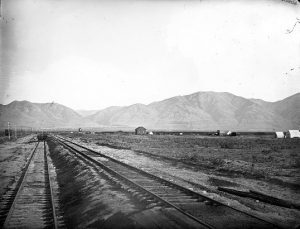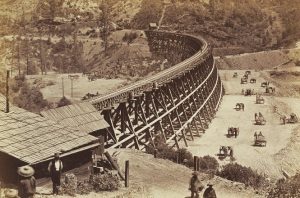
If you're in the state of Utah this month, you've probably heard about numerous celebrations about something called 'Spike 150' or the 'transcontinental railroad' or 'Promontory Point.' Spike150 is a state-wide celebration of the 150th anniversary of the joining of the Central Pacific and Union Pacific railroads at Promontory Point, Utah, in 1869, which created the first transcontinental railroad.
But what's the big deal with the transcontinental railroad? Travel and commerce changed significantly and instantly with a transcontinental railroad. A journey across the United States, which previously took four months now took only three and a half days. The rate at which people traveled and goods were shipped increased at a previously impossible rate. Rich mineral and ore deposits attracted more rail companies, which increased the economy and industry throughout the state and the region. Along with that, ideas and information from both sides of the country and everywhere in between could be shared more quickly as well.
Utah and the Railroad
Promontory Summit in the Utah Territory was chosen as the site of the meeting of the railroad by representatives from the Central Pacific and Union Pacific railroads. By the early 20th century, regional and urban rail lines accommodated transportation between and within local Utah cities. Some Utah towns like Thistle and Helper evolved as a result of the railroad, and their fortunes directly followed the rise and fall of the railroad industry.

The arteries and smaller rails throughout the area were often called 'Mormon Roads,' because of the involvement of local Latter-day Saints in constructing the rail lines that transformed the remote, arid region into a burgeoning western hub. In 2007, Utah commemorated the historic event of the joining of the rails at Promontory by choosing a depiction of this event to be on the Utah state quarter.
Important Issues with the Transcontinental Railroad
Of course, it took thousands of people to build these railroads, which introduces issues such as underpaid and under-recognized laborers. The bulk of early routes were built by former slaves from the defeated Confederacy, refugees from Ireland, and workers recruited from China. After the discriminatory policies of the Chinese Exclusion Act of 1882, railroads began to employ workers from other countries, including Japan, India, and Mexico.

Another issue intimately tied with the construction of the transcontinental railroad is that, in order to make way for development, the federal government pushed out existing indigenous peoples. In some cases, the railroads directly assisted with their removal. In others, railroad managers appropriated native peoples as ceremonial props, an attempt to portray the transcontinental as an accepted part of the western landscape. The transcontinental railroad was an event and an invention that radically changed America, both for good and for ill. It undoubtedly made travel and commerce possible in ways that had never before been imagined and provided a rich resource for the state of Utah.
Spike150
Spike150 celebrations are ongoing throughout the state and include many exhibitions at museums and other cultural institutions around the state. The celebrations and exhibitions seek to highlight the famous as well as the untold stories of the people and events surrounding the transcontinental railroad. The MOA is partnering with several institutions for a series of Spike150 Instagram takeovers which you can find in the Highlights of our Instagram (@byumoa). The MOA's own exhibition, After Promontory—open now through October 5, 2019— celebrates this sesquicentennial anniversary.